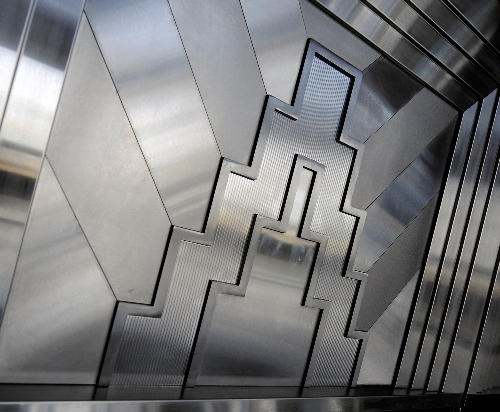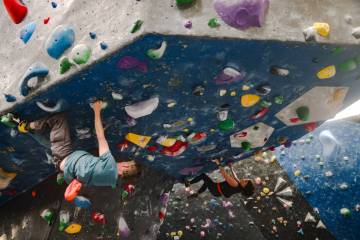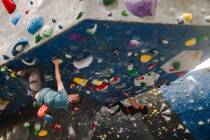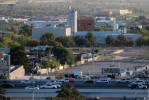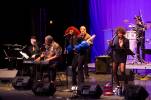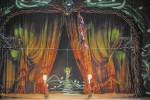Smith Center designed to delight with hints of whimsy and history
Nearly half a billion dollars went into The Smith Center's design and construction.
That's serious money even by Las Vegas standards. But if you laugh when you first lay eyes on it, that's OK with lead designer and architect David Schwarz. Buildings are supposed to amuse, especially the expensive ones.
Exactly what will strike your funny bone depends entirely on what draws your eye in the facility's design. Maybe it will be the pig statue in the Founders Room. It's whimsical and seems entirely out of place until you discover it was a favorite of the late Mary B. Smith, for whom the center is named along with her husband, former Donrey executive Fred W. Smith, chairman of the Donald W. Reynolds Foundation. Or the iris designs that can be found as decorative touches throughout the facility. Another Mary B. Smith favorite.
Maybe it will delight you to discover all the ways in which Hoover Dam is represented in the architecture. It was the overarching inspiration for The Smith Center's art deco style. The facility, spread out over five acres, has dozens of ways in which it will amuse, inspire and delight. It's all part of The Smith Center's personality, says Schwarz, a Washington, D.C.-based architect.
"We believe buildings should have personalities," Schwarz says of his design team. "Buildings should amuse and entertain. I want the experience of architecture to be emotional instead of intellectual. I want you to say, 'Wow, cool, this feels great for me.' "
Three principles guided the design of The Smith Center, says Myron Martin, its president and CEO. It had to be timeless, seeming as though it could have been built today or 100 years ago or 100 years from now. It also had to be made of durable materials that would last over generations. And the design had to be so elegant that it conveyed a sense of specialness to its visitors. People needed to feel comfortable but also know they were in a distinguished building that holds an important role in the community.
Nearly three years after construction started on The Smith Center, Martin and Schwarz believe they have that in the finished product.
Its exterior is made of 2,458 tons of Indiana limestone, a material that is strongly associated with important buildings throughout the country. A classic and stately European style is reflected in the architecture, inspired by some of the world's most famous opera houses and theaters.
As to the focal point of the facility, that depends on whether you're inside or out, Schwarz says, and also where your personal interests lie. To some, the centerpiece is the 16-story Carillon Tower that houses custom-made carillon bells. It is the most obvious external feature, Schwarz says. For others, the central focal point is the main performance area, Reynolds Hall.
The tower will play an important role for the center, Martin notes. It overlooks Symphony Park, a verdant stretch of grass that will be the site of many outdoor performances.
"I think it's important to understand why we have a bell tower," Martin says.
When The Smith Center was in its early conceptual form, the land it now sits on was empty. It was believed that office towers and their parking structures would eventually surround it. The parking facilities would probably have been about the same height as The Smith Center itself, Martin says. So designers came up with the idea to build a bell tower that would make it stand out and "soar above" other structures.
The notion of making the whole building a musical instrument appealed to them, as well, Martin says. Inside, music would be played onstage; outside, the carillon bells would ring, drawing the surrounding community into the performance. No one will have to walk inside to experience The Smith Center.
The tower design is reflected throughout the building. Even the elevator lights are in the shape of a tower. Iconography in a building always is tied to its location and the people who made the building happen, Schwarz says. Hence, the iris designs, pigs and Hoover Dam influences and others found throughout The Smith Center.
Before designing the complex, Schwarz looked for a way to tie it uniquely to Las Vegas. Every other piece of the world was already represented on the Strip in some way; The Smith Center had to be about Las Vegas. Schwarz felt that the valley's identity was strongly connected to Hoover Dam, as the city didn't flourish until after it was built. In addition to the art deco influences, the dam's Penstock Towers serve as The Smith Center's iconic logo.
Discovering the facility's iconography will be part of the overall experience for patrons, Schwarz and Martin say. One has only to glance around the Grand Lobby of Reynolds Hall to see some of those icons in the bar fronts, door handles and friezes. Of course, it will be difficult to decide where to look first once you're inside the Grand Lobby. Above, three 17-foot-long chandeliers hang from the ceiling. Italian marble covers the floors and walls. A stainless-steel staircase beckons visitors to climb up to the balcony that overlooks the lobby.
There isn't a bad seat among the 2,050 in Reynolds Hall, as it was uniquely designed so that sight lines are not obstructed. The horseshoe-shaped venue features stacked balconies that create an intimate vibe for theatergoers.
The iconography extends from the lobby into the theater by virtue of the terrazzo floors, where you will notice the tower shape everywhere. The vastness of the hall comes together at the top of the ceiling where it appears daylight is shining through a metal and glass sculpture. But it's a carefully crafted illusion, Martin says.
Two additional performance spaces, the 250-seat Cabaret Jazz and the 258-seat Troesh Studio Theater, both in Boman Pavilion, were designed to give The Smith Center a place to provide a performing arts experience to the whole community, including jazz lovers and schoolchildren.
"A performing arts center speaks to the highest cultural aspirations of its community," Schwarz says. "The cultural aspirations of Las Vegas are extraordinarily high and I wanted our building to reflect that."
According to local architects, it does. Even if you don't like art deco, The Smith Center will inspire because it is a state-of-the-art performing arts center, something that the city has never had before.
"Whenever a community invests in their cultural infrastructure, it's a fantastic thing," says David Baird, director of the School of Architecture at the University of Nevada, Las Vegas. "I think The Smith Center is a fantastic project for that reason."
Stylistically, Baird leans toward contemporary design. Some may think The Smith Center should have incorporated more modern touches, he says, or shouldn't be so strongly associated with Hoover Dam. But architecture is secondary to having a facility that will support arts programming and draw outside attention, he adds.
"Certainly the dam is a huge part of our history. It's largely why we're here, right?" Baird says. "So I don't think it's a silly thing to pay homage to it."
The dam also was a significant investment in the valley's infrastructure. It supports economic development. The Smith Center, Baird says, is similar in that it is a cultural infrastructure piece. That makes it more important than any stylistic aspects. Every great city has robust cultural assets that attract people to live there, he adds. The American economy and society is largely driven by entertainment, leisure and the arts and they're growing in significance. Because of that, The Smith Center will be invaluable to Las Vegas.
"This is setting its own precedent," says Glenn Nowak, interim director of the Downtown Design Center. He teaches studio classes to UNLV architecture students and has taken some on tours of The Smith Center when it was under construction.
What is most remarkable about the building, he says, is what isn't visible to the eye. It is so well-designed acoustically that it stands out among all other local architecture.
"I appreciate the aesthetics because it is so different from what we've got," Nowak says.
"I'd like to see it more in tune with our desert environment but it's doing something that Las Vegas has never seen before. There aren't any world-class halls in the Mojave Desert. So it's setting its own precedence."
Contact reporter Sonya Padgett at
spadgett@reviewjournal.com
or 702-380-4564. Follow @StripSonya on Twitter.





